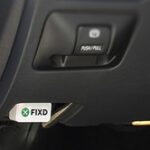The Canon CanoScan LiDE 110 scanner is known for its user-friendly design and portability, making it a popular choice for home and small office use. This flatbed scanner offers a straightforward way to digitize documents and photos. If you’re looking to get started or need a refresher on using this scanner, this guide will walk you through the essential steps.
Getting Started with Your Canon LiDE 110 Scanner
Setting up your Canon LiDE 110 scanner is a simple process, primarily involving physical connection and software installation.
Unboxing and Initial Setup
- Unpack your scanner: Carefully remove the Canon LiDE 110 scanner and its components from the box. You should find the scanner unit and a USB cable.
- Connect the USB cable: The Canon LiDE 110 is powered and operated via a single USB connection. Plug the USB cable into the designated port on the back of the scanner and connect the other end to a USB port on your computer. Ensure the connection is secure at both ends. A common issue reported by users is a “cable not connected” error. This can often be resolved by ensuring a firm connection or trying a different USB port on your computer.
A Canon CanoScan LiDE 110 flatbed scanner, highlighting its compact and sleek design for home or office use.
Software Installation
To fully utilize your Canon LiDE 110 scanner, you’ll need to install the necessary software.
- Install Drivers and Software: Typically, a driver and software suite like MP Navigator EX and Solution Menu are provided with the scanner, either on a CD or available for download from the Canon support website. Visit the official Canon support website and search for “CanoScan LiDE 110 drivers”. Download the appropriate drivers and software for your operating system (like macOS or Windows).
- Follow Installation Instructions: Run the downloaded installer file and follow the on-screen prompts to install the software. This software suite is crucial as it provides the interface to control the scanner’s functions, adjust settings, and manage your scanned documents.
A screenshot of the Canon scanner software interface, showing options for document scanning, photo scanning, and custom settings adjustments on a computer display.
Scanning Documents and Photos
Once the setup is complete, you can start scanning documents and photos.
Basic Scanning Steps
- Place your Document: Open the scanner lid and place your document face-down on the scanner glass. Align your document with the markings on the scanner bed to ensure correct orientation.
- Launch the Scanning Software: Open the installed Canon scanning software (e.g., MP Navigator EX or Solution Menu) from your computer’s applications menu.
- Select Scan Type: Within the software, choose the type of scan you want to perform, such as “Document Scan” for text documents or “Photo Scan” for images.
- Preview Scan: Click the “Preview” button in the software interface. This will perform a quick pre-scan, allowing you to see how the document is positioned and how the scan will look.
- Adjust Settings (Optional): Before the final scan, you can adjust settings like resolution (DPI), color mode (color, grayscale, black and white), and file format (PDF, JPEG, etc.). For standard documents, a resolution of 300 DPI is usually sufficient. For photos, you might want to use a higher resolution for better quality. The Canon LiDE 110 can achieve an enhanced scan resolution up to 19200 x 19200 DPI, and an optical resolution of 2400 x 4800 DPI.
- Execute Scan: Click the “Scan” button to start the final scan. The scanner will process the document, and the scanned image will appear in the software interface.
- Save Your Scan: Once the scan is complete, you’ll be prompted to save your scanned document or image. Choose a file name and location on your computer to save the file. The Canon LiDE 110 scanner supports saving files in PDF format, which is ideal for documents.
An overhead view of a hand placing a document onto the glass surface of a Canon LiDE 110 scanner, ready for digitization.
Understanding Scan Settings
- Resolution (DPI): Dots Per Inch (DPI) determines the detail level of your scan. Higher DPI means more detail and larger file sizes. For most documents, 300 DPI is adequate. For high-quality photo reproduction, consider using 600 DPI or higher.
- Color Mode: Choose “Color” for color documents and photos, “Grayscale” for black and white photos or documents with shades of gray, and “Black and White” for purely text-based documents to reduce file size.
- File Format: PDF is excellent for documents as it preserves formatting and is universally readable. JPEG is suitable for photos when file size is a concern, though it compresses image quality slightly.
Troubleshooting Common Issues
While the Canon LiDE 110 is generally reliable, you might encounter occasional issues.
- “Cable Not Connected” Error: As mentioned earlier, this is often due to a loose USB connection. Ensure the cable is firmly plugged in. Try a different USB port on your computer. If the problem persists, restart your computer and scanner software.
- Scanner Not Recognized: If your computer doesn’t recognize the scanner, ensure you have installed the correct drivers. Reinstalling the drivers can often resolve this. Check the Device Manager (on Windows) or System Information (on macOS) to see if the scanner is listed and if there are any driver errors.
Conclusion
The Canon CanoScan LiDE 110 scanner provides a simple and effective way to digitize your documents and photos. By following these steps, you can easily set up and use your scanner for everyday scanning tasks. Its compact design and ease of use make it a valuable tool for digitizing your important papers and cherished memories. Remember to always refer to the official Canon manual for the most detailed instructions and troubleshooting tips.
The Canon logo, representing the brand and manufacturer of the LiDE 110 scanner and associated products.

